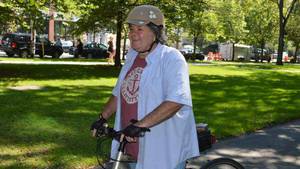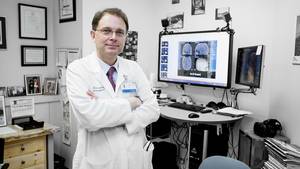It’s often said that in a health crisis, or near-death experience, your life flashes before your eyes. While this may be true for some, it wasn’t for Ed Hickey.
The 43-year-old financial planner, and single father of two, says that when he suffered a near fatal heart attack while playing hockey two years ago, he remembers thinking of only two things.
“First, it was my kids,” he says. Thoughts of his then 14-year-old daughter and 12-year-old son were first on his mind at the rink in Bedford, NS, on January 13, 2011. Ed was fading in and out of consciousness on a hockey bench while worried teammates surrounded him. He lay prone as medical personnel worked furiously to restart his heart with a defibrillator.
Although Ed was then, and remains today, athletic, non-smoking, fit and healthy, along the wall of his left anterior descending artery — an artery crucial to heart function — a piece of plaque had broken loose and lodged itself across the artery passage way, blocking blood flow to his heart. The blockage started causing severe trauma to the heart muscle, sending him into cardiac arrest.
“My kids were home alone and I remember thinking that I likely wouldn’t be there anytime soon, and that I needed someone to go to them,” he says. “The second thing — and this is the truth — is that I was thinking ‘damn, I just bought these skates, they cost me over $600 and I’m not sure I’m going to get to use them after this.’ ”
Fortunately for Ed, he’s using his skates again. Since his heart attack, he’s been able to get back on the ice and move on with his life. Ed returned to work and to the same level of fitness and state of health he has always enjoyed.
Thanks to the medical professionals who happened to be at the rink that night — as luck would have it, on the Capital Health hockey team lacing up in the dressing room — and thanks to emergency responders, and ultimately, the cardiology team at the QEII Health Sciences Centre’s emergency room (ER), Ed Hickey lived to tell his story.
But, there’s another reason why Ed is alive today. The efforts of the medical personnel who attended to him that night were aided immeasurably by a new QEII cardiology program that uses a procedure called Primary Percutaneous Coronary Intervention (Primary PCI), also known as angioplasty.
Whereas severe heart attack patients traditionally are given clot-busting (thrombolytic) drugs as the first treatment of choice, angioplasty is now favoured if readily available. Practice has shown that it saves more lives and allows for a faster recovery.
Compared to clot-busting drug therapy, angioplasty has reduced the average hospital stay to three to four days, from seven to 10 days previously. Although clot-busting drugs were a major advancement in treating heart attacks — the treatment reduced the death rate to 12 per cent, where it hovered for 20 years — angioplasty has reduced the mortality rate even further, down now to fewer than 10 per cent.
The QEII rolled out the Primary PCI program in 2005 with ER patients only. It was then expanded to all patients suffering a major heart attack who could get to the QEII’s cardiac catheterization laboratory (cath lab) within a 90-minute driving radius.
Now, 24 hours a day, seven days a week, all patients who suffer major heart attacks, and can be transported within 90 minutes, are taken directly to the QEII’s cath lab where they are met by an interventional cardiologist and the entire team. The patient then undergoes an emergency procedure to open the blocked artery that caused the heart attack, with a balloon and a stent.
Dr. Catherine Kells, head of cardiology, explains why the 90-minute window is critical.
“Time is muscle,” she says, pointing out that the transportation period is time that the patient is getting no blood to their heart.
“Studies have shown that under 90 minutes offers the best chance of success,” she says. “Once you go over 90 minutes the success rate drops.”
There is also a province-wide Rescue PCI program. This treatment is given to severe heart attack patients, outside the 90-minute transportation area, who do not respond to clot-busting drug treatment. When possible, these patients are transported via Life Flight helicopter to the QEII’s cath lab for emergency rescue PCI.
Angioplasty not only breaks the blood clot, says Dr. Kells, it also fixes the narrowing in the artery. She points out that the procedure benefits individual patients, because it means they get to go home faster, as well as the entire health care system, because it frees up beds for other patients and reduces health care costs.
“It has taken a team of people to make the program a success,” says Dr. Kells. “Every person on the team is critically important — if one person doesn’t do his or her job then it doesn’t work. We couldn’t do it without emergency responders, doctors, technicians and every single hospital staff person. We’re a team.”
Ed agrees. Since his heart attack he hasbecome an ambassador for heart health in the local medical community. He spoke about his experience as a guest at the Heart and Stroke Foundation's annual luncheon in Halifax, in November 2012. He’s also raises funds, and is a participant in the 2013 BMO Hockey Heroes Weekend scheduled for Halifax April 19-21.
“While you can’t always prevent a health crisis,” says Hickey, “with the right medical personnel, equipment, and procedures you can recover and get back to living life the way you used to.”








